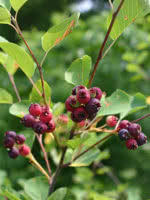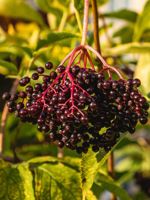Mon-Fri 9am - 5pm Mountain time
Honeywood Saskatoon (Serviceberry) vs Bob Gordon Elderberry
Amelanchier alnifolia Honeywood
Sambucus canadensis Bob Gordon
NOT AVAILABLE THIS SEASON - MIGHT RETURN
Honeywood Saskatoon, also known as Serviceberries, is excellent at producing an abundance of blue-coloured berries in mid-summer and has dark green foliage that turns yellow in the fall. It is quite large making it a perfect shrub in your backyard garden. Often grown for its edible qualities, the Honeywood Saskatoon is quite ornamental with stunning white blooms in the spring.
Bob Gordon Elderberry is a Black Elderberry cultivar that produces berries that are larger and sweeter than other varieties, making it one of the top cultivars. It produces large clusters of white flowers that turn into large clusters of dark purple to black berries. The berries are well-suited for baked goods, jams, jellies, and syrups. It was selected from the wild in Missouri.
The large berry clusters that the Bob Gordon Elderberry produces will often end up hanging downward. This makes it more difficult for birds to feed on the berries. If birds are a concern, this might be the right berry for you.
Black Elderberries are considered to be partially self-pollinating. So while they will still produce some berries without cross-pollination, planting with another variety will increase yields. Consider planting with Black Elderberry or Ranch Elderberry.
Warning: the seeds, stems, leaves, roots, and uncooked berries are toxic to humans when eaten in quantity. Berries should be cooked to make them safe for human consumption.
Honeywood Saskatoon (Serviceberry) Quick Facts
Bob Gordon Elderberry Quick Facts
Toxicity: leaves, stems, and uncooked berries are poisonous to humans

